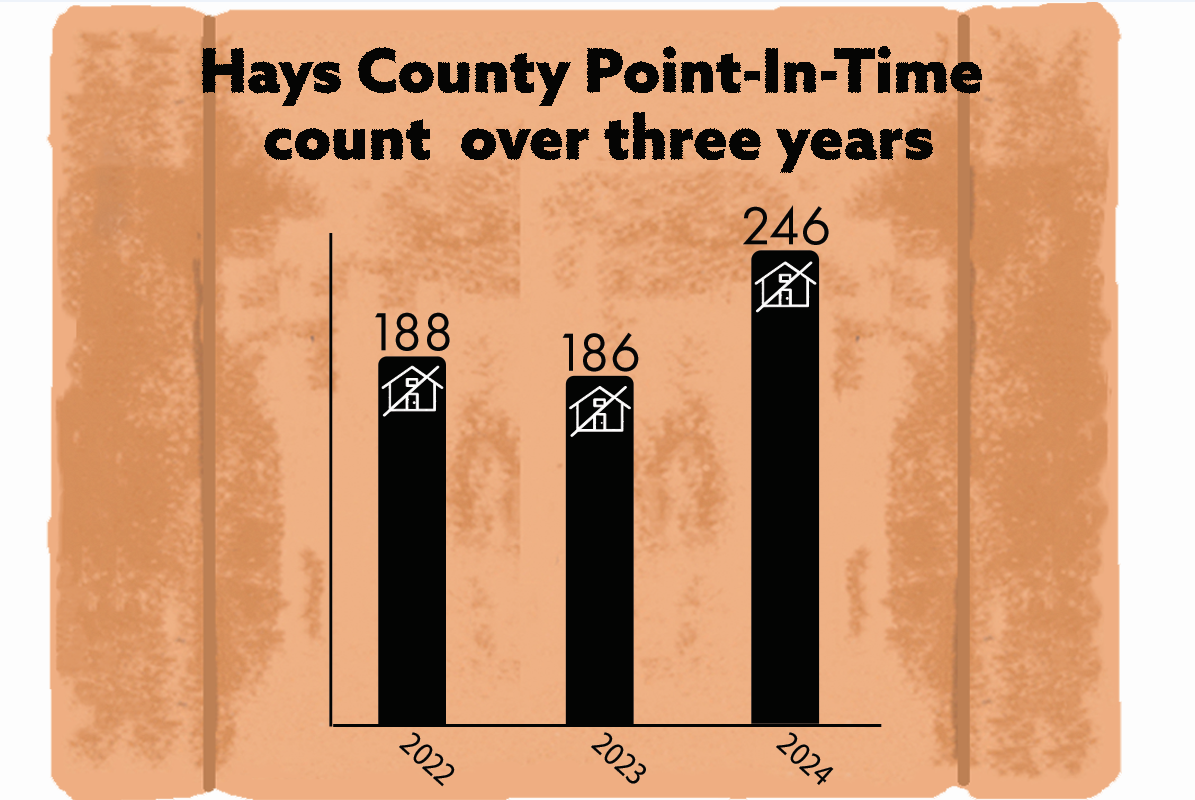According to the Point-In-Time (PIT) count, Hays County experienced a 32% increase in unhoused individuals from 2023 to 2024, prompting county resources to address the need.
The PIT count is an annual survey conducted in the U.S. by area to count individuals experiencing homelessness, sheltered or unsheltered, on a single night in January. Its goal is to provide data for assessing the scope of homelessness and informing policies to address it.
The 2024 Hays County PIT count was presented to the Hays County Commissioners Court on April 23. The results found an increase from 186 unhoused residents in 2023 to 246 in 2024 in Hays County.
According to Kasandra Vesper, a Southside Community Center case manager, the increased unhoused population has subsequently increased the workload for homeless resources such as Southside Community Center.
“When I first started [in August 2022], dinners were max maybe 20 [unhoused individuals],” Vesper said. “Now [Southside] can see anywhere from 30 to 40 in one given day,” Vesper said.
Vesper said Southside Community Center is the largest outreach center in San Marcos and provides free dinner, housing and case management to aid unhoused individuals directly.
Shanna O’Brien, head of Neighborhood Enhancement for the city of San Marcos, said the city has experienced a noticeable increase in its unhoused population over the past few years largely due to rising housing costs.
“Affordable housing is definitely a huge factor that has caused some of our residents to become unhoused… a lot of [unhoused individuals] have jobs but they just don’t make enough to pay rent,” O’Brien said.
Karhonda Tyler, an unhoused resident of San Marcos, said the increased population has constrained the resources offered to unhoused individuals.
According to Tyler, who uses Southside Community Center as a resource, its services have been increasingly rationed in recent months.
“[Clothes washing] used to be 8 a.m. to 9 p.m. [at the community center], now it’s only 1 to 4 p.m.,” Tyler said. “[Southside] gives away a lot of stuff… but [there are] a lot of people, so resources do run slim.”
Tyler said it is often difficult for her to get to Southside Community Center because she does not have adequate help from the city to travel across the city to reach homeless resources.
“It doesn’t matter where [unhoused individuals] are in San Marcos, they have to come [to Southside],” Tyler said. “There are no buses on the weekends, so if you’re on the other side of San Marcos, you gotta walk here unless you got somebody to help… and it’s just me, myself and I.”
According to Vesper other resources for unhoused individuals, such as the Hays-Caldwell Women’s Center, have also been struggling with the increased unhoused population. She said the Hays-Caldwell Women’s Center is transitioning to a waitlist for emergency housing because of high demand.
Rev. Joshua Sutherlun and Nancy Heintz, co-chairs of the Homeless Coalition of Hays County (HCHC), the umbrella organization representing several different homeless advocacy groups in Hays County, said the current state of homeless outreach is insufficient for the needs of the community.
“Within the county as a whole… we have the resources to meet the needs [of the unhoused population],” Sutherlun said. “But [Hays County] does not necessarily have an organized plan.”
Heintz said the county-wide approach to addressing homelessness would involve coordination across the county to ensure resources are used effectively.
“It would really mean you would have some kind of contact point in the different towns across the county,” Heintz said. “This means wherever somebody has an issue [there would be] some kind of resource to help stabilize them.”
According to O’Brien, a $700,000 resource plan is in production, but specifics are not ironed out yet. O’Brien said she will present the plan to San Marcos City Council in the near future.
Vesper said for resources such as Southside Community Center, improvements are underway to meet the growing demand.
“Truthfully, [Southside needs additional] case management, but we just aren’t at that point now funding-wise,” Vesper said. “[Southside] is almost there; we are looking to get a few case managers and things of that nature.”




















